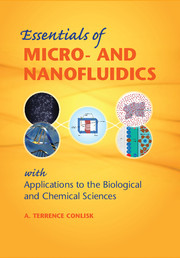Book contents
- Frontmatter
- Contents
- Preface
- 1 Introduction and Overview
- 2 Preparatory Concepts
- 3 The Governing Equations for an Electrically Conducting Fluid
- 4 The Essentials of Viscous Flow
- 5 Heat and Mass Transfer Phenomena in Channels and Tubes
- 6 Introduction to Electrostatics
- 7 Elements of Electrochemistry and the Electrical Double Layer
- 8 Elements of Molecular and Cell Biology
- 9 Electrokinetic Phenomena
- 10 Essential Numerical Methods
- 11 Molecular Simulations
- 12 Applications
- Appendix A Matched Asymptotic Expansions
- Appendix B Vector Operations in Curvilinear Coordinates
- Appendix C Web Sites
- Appendix D A Semester Course Syllabus
- Bibliography
- Index
4 - The Essentials of Viscous Flow
Published online by Cambridge University Press: 05 February 2013
- Frontmatter
- Contents
- Preface
- 1 Introduction and Overview
- 2 Preparatory Concepts
- 3 The Governing Equations for an Electrically Conducting Fluid
- 4 The Essentials of Viscous Flow
- 5 Heat and Mass Transfer Phenomena in Channels and Tubes
- 6 Introduction to Electrostatics
- 7 Elements of Electrochemistry and the Electrical Double Layer
- 8 Elements of Molecular and Cell Biology
- 9 Electrokinetic Phenomena
- 10 Essential Numerical Methods
- 11 Molecular Simulations
- 12 Applications
- Appendix A Matched Asymptotic Expansions
- Appendix B Vector Operations in Curvilinear Coordinates
- Appendix C Web Sites
- Appendix D A Semester Course Syllabus
- Bibliography
- Index
Summary
Introduction
As discussed in Chapter 1, many of the current or planned microdevices contain rectangular channels arranged in an array; such channel systems are termed nanopore membranes. For example, the nanopore membranes depicted in Figure 1.1 contain up to 30,000 channels, depending on the channel height, which is the nanoscale dimension. Scanning electron microscope (SEM) images of nanopore membranes fabricated by Dr. Shuvo Roy's group at the Cleveland Clinic1 are depicted in Figure 4.1. You will recognize Figure 4.1(a) as Figure 1.1(b), and is repeated for clarity. The nanopore membrane is fabricated so as to contain channels of a uniform nanoscale height. They fabricated membranes with a variety of pore sizes, ranging from h = 6.3 nm to h = 91 nm, and there are 11, 500 pores per membrane. Similar membranes are now being used in the development of an artificial kidney (Fissell, 2006). Obviously, it would be difficult to model the flow in such an array from first principles.
There are at least two ways to overcome this problem: (1) treating the membrane as a porous media problem, the membrane being characterized by a permeability and a porosity, and (2) investigating the flow in each channel separately, assuming that the flow behaves similarly in each individual channel. It is the latter approach that is explored here.
Information
- Type
- Chapter
- Information
- Essentials of Micro- and NanofluidicsWith Applications to the Biological and Chemical Sciences, pp. 140 - 179Publisher: Cambridge University PressPrint publication year: 2012
